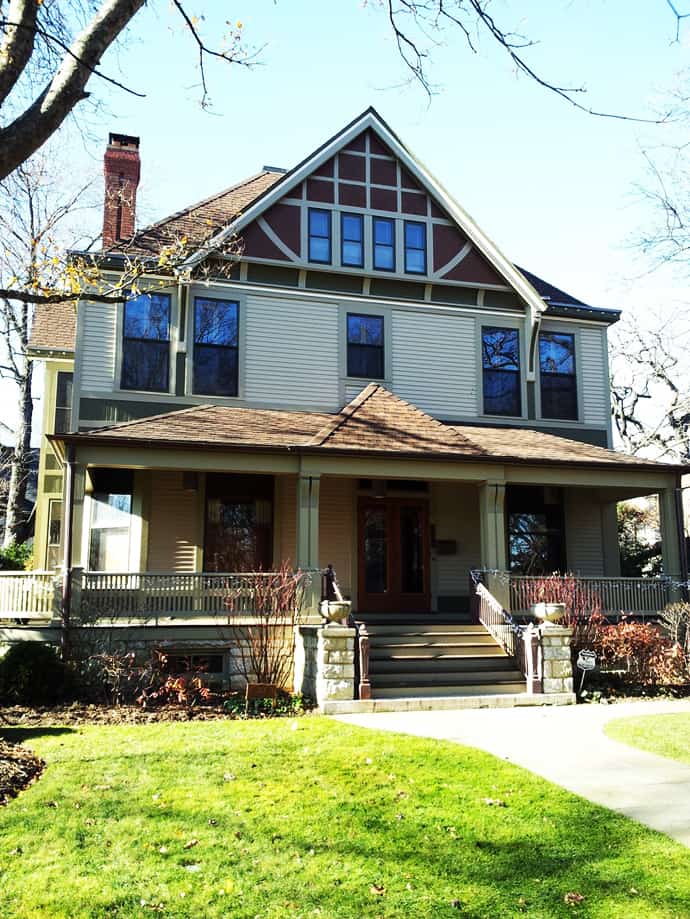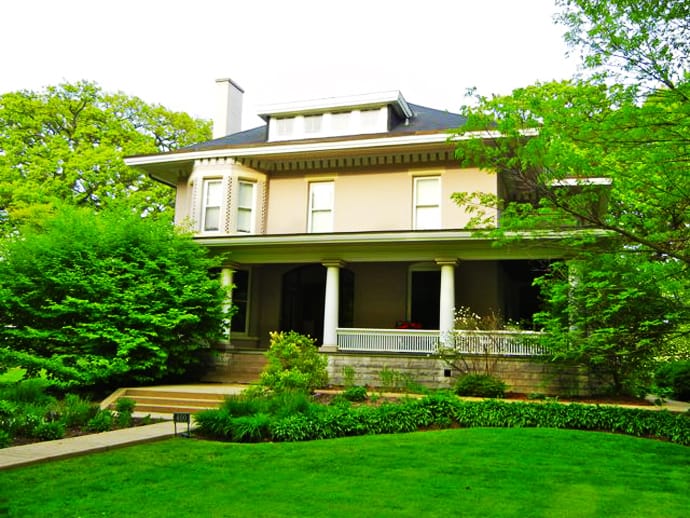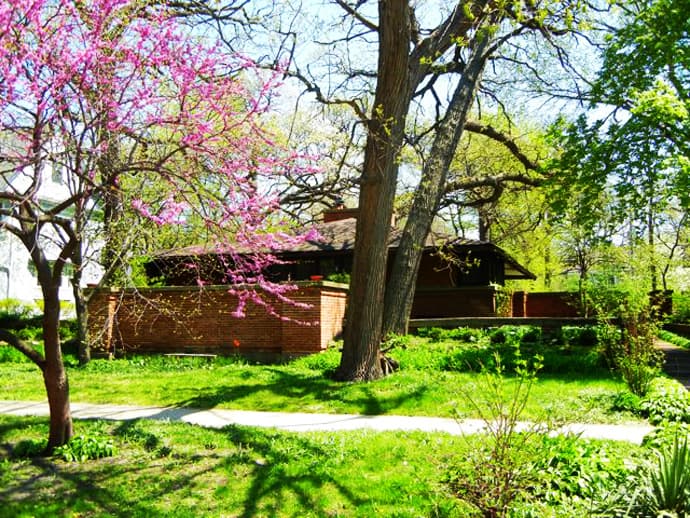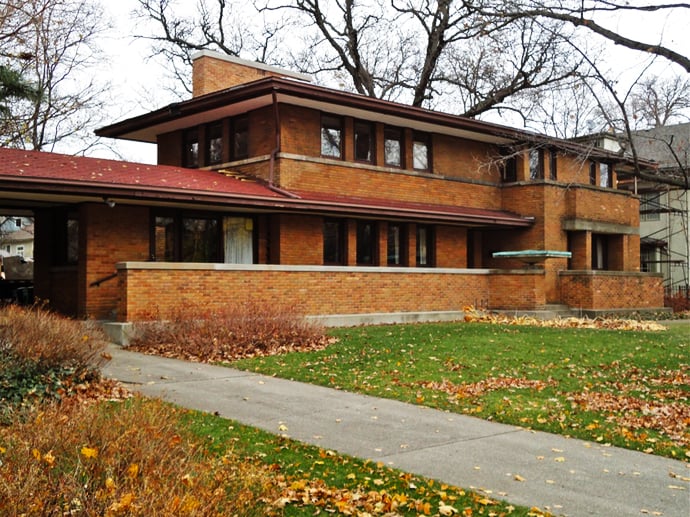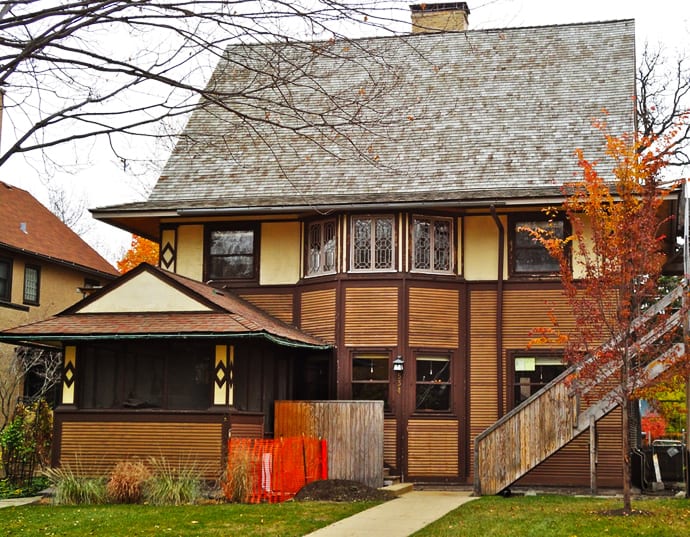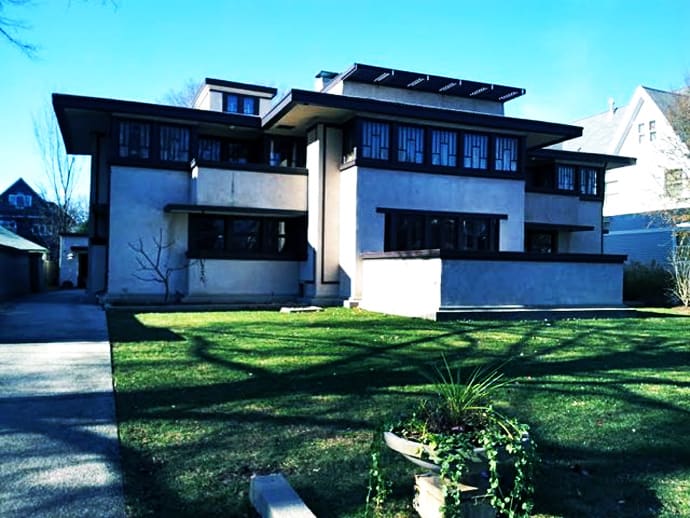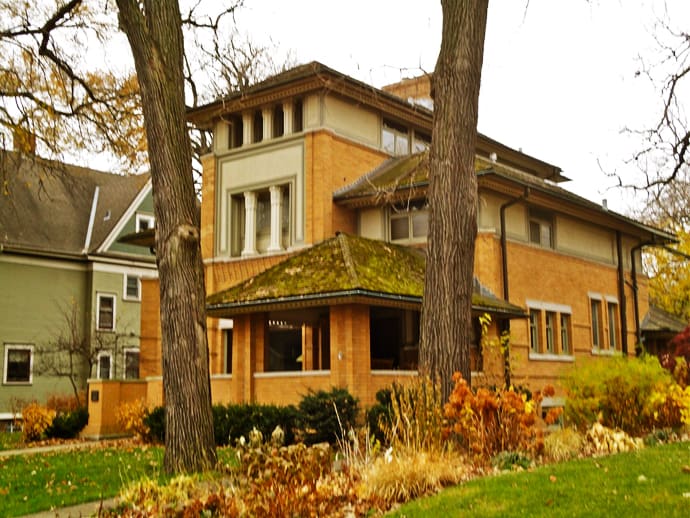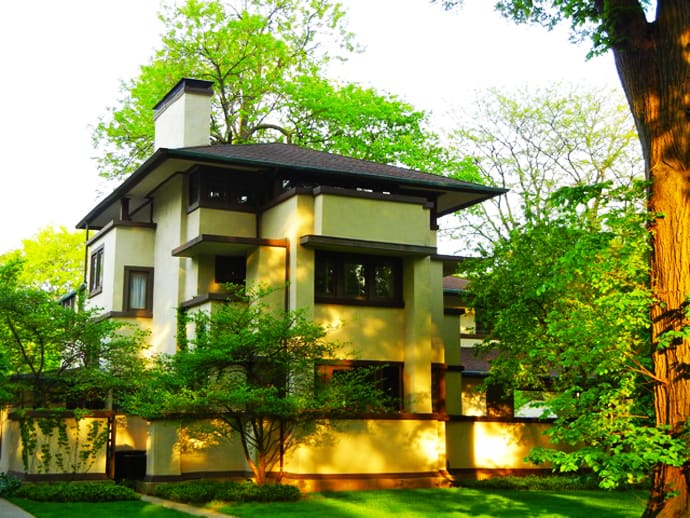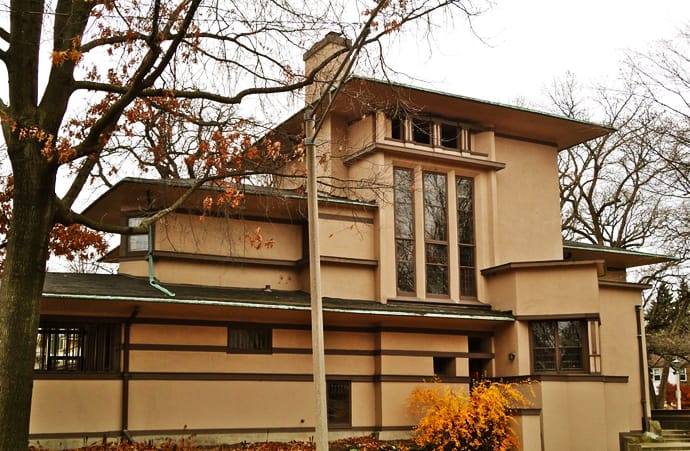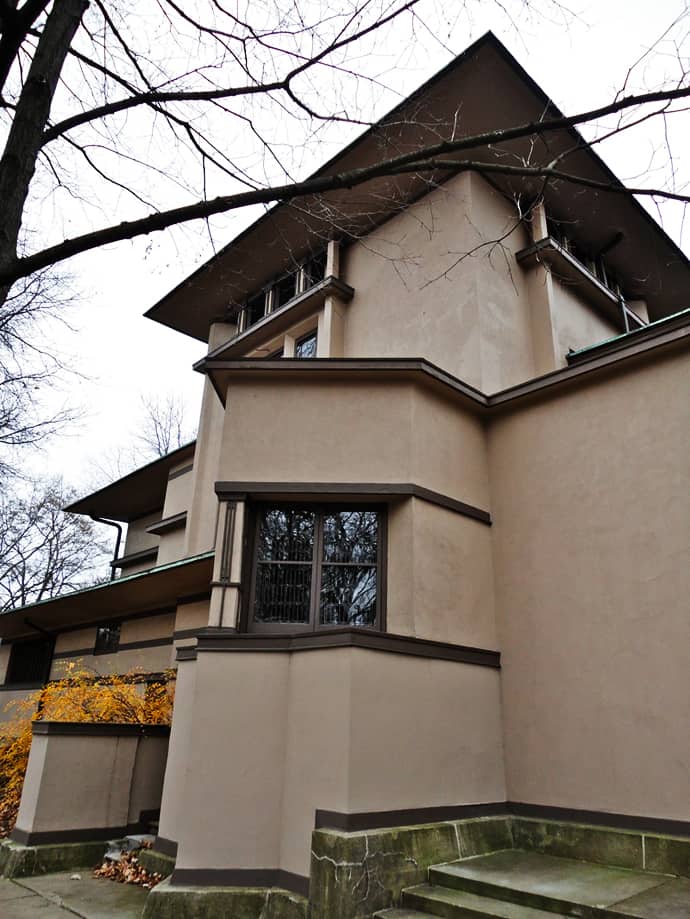Charles E Roberts House Remodel, Frank Lloyd Wright 1896
Frank Lloyd Wright was hired by Charles E Roberts to remodel this house in 1896. Although unremarkable in its features, the house bears much historical significance in the fact that it was originally designed by Burnham and Root in 1879. This is the only house worked on by both of these brilliant architectural sources. The same sequence of architectural design would be seen almost a decade later when Wright remodeled the lobby of Burnham and Root’s Rookery Building in 1905.
view more: thefranklloydwrighttour.com
William Copeland House Remodel, Frank Lloyd Wright 1909
The William Copeland House does not immediately evoke Frank Lloyd Wright because it was not built from the ground up, rather, it is a remodel. The original Copeland House was built in the late 1870’s and designed in the Italianate style. The Copeland’s hired Frank Lloyd Wright in 1909 to remodel their house in the Prairie mode, similar to some of his other work on Forest Avenue in Oak Park. Frank Lloyd Wright stripped the Italianate ornament off of the building, flattened out the roof lines -note the two, strong horizontal lines created by the roofs, and modified the dormer. Originally there were only two dormer windows, Wright brought it out to four, thus bringing out another horizontal line. There is a strong sense of geometry in both the dormer windows and the entry, but most of the work Wright carried out was inside. Frank Lloyd Wright knocked down the interior walls to give it an open floor plan, bordered it with wooden trim, and painted it Prairie colors.
Edwin Cheney House, Frank Lloyd Wright, 1903
The Edwin Cheney House was completed in 1903 and is a fully mature Prairie Style Home designed by Frank Lloyd Wright. The Edwin Cheney House rests on a concrete stylobate; is long, flat, and horizontal; has a low hipped roof; has beautifully orchestrated art glass windows; has a broad, central chimney; and overall is very well connected to the nature on which it rises from. Though the Edwin Cheney House appears small, it is actually quite large with four bedrooms. The house is two floors. In the front of the Cheney House, the first floor is partially submerged underground, but the foundation of the building shifts in the back of the property where both floors are fully exposed. The privacy wall in front dominates the house, and gives little indication to the passerby of what lies beyond.
Hills-DeCaro House, Frank Lloyd Wright, 1906/1977
The Hills-DeCaro House sits on the lot adjacent to the Nathan Grier Moore House, with a large gap in between the two. Nathan Moore purchased the two lots next to his Frank Lloyd Wright designed Tudor Revival home, and had Frank Lloyd Wright remodel what was then a Stick Style House on the adjoining lot as a wedding gift to his daughter and son-in-law the Hills’. Frank Lloyd Wright completely remodeled the home, rendering the original house unrecognizable. He made it more Prairie Style with its over hanging eaves, and beautiful art glass windows, but one can also see the Japanese influence of Frank Lloyd Wright with its pagoda style roofs.
George Furbeck House, Frank Lloyd Wright, 1897
The Harry Adams House was the last house designed by Frank Lloyd Wright in Oak Park, completed in 1913. It is a pristine example of a fully mature Prairie Style house to cap Frank Lloyd Wright’s Oak Park period. Originally, when the Adams’ contacted Frank Lloyd Wright to build them a home, the design he came up with was far out of their budget. They subsequently contacted a different architect to build them a Wright-like home -this too was still out of their budget. They went back to Wright who reluctantly agreed to scale down the home to fit within their budget. The Harry Adams House has a very low hipped, almost flat roof; a broad central chimney; it rests on a concrete stylobate; and it maintains a long, flat, horizontal appearance. One of the scale backs of the Harry Adams House included using only art glass windows on the top floor. Additionally, the Harry Adams House is the only Frank Lloyd Wright House in Oak Park that has a car port.
Harry Adams House, Frank Lloyd Wright, 1913
The Edwin Cheney House was completed in 1903 and is a fully mature Prairie Style Home designed by Frank Lloyd Wright. The Edwin Cheney House rests on a concrete stylobate; is long, flat, and horizontal; has a low hipped roof; has beautifully orchestrated art glass windows; has a broad, central chimney; and overall is very well connected to the nature on which it rises from. Though the Edwin Cheney House appears small, it is actually quite large with four bedrooms. The house is two floors. In the front of the Cheney House, the first floor is partially submerged underground, but the foundation of the building shifts in the back of the property where both floors are fully exposed. The privacy wall in front dominates the house, and gives little indication to the passerby of what lies beyond.
Harry Goodrich House, Frank Lloyd Wright, 1896
The Harry Goodrich House was completed by Frank Lloyd Wright in 1896. The Harry Goodrich House is one of Frank Lloyd Wright’s transitional/experimental homes leading up to the Prairie Style. Like the Francis Woolley House, the horizontal clapboard siding is brought up to the second level of the home. Geometrical windows form the bay that pushes out of the front of the house. The most interesting feature of the home, though, is the roof -it appears as if Frank Lloyd Wright took a high pitched roof and placed it on top of a low hipped roof, making the house look as if it’s wearing a party hat.
Oscar Balch House, Frank Lloyd Wright 1911
The Oscar Balch House was one of Frank Lloyd Wright’s final projects in Oak Park. By this point in 1911, Wright had just returned from Europe and was living up at Taliesin, with frequent commutes to Chicago for business. The house is perhaps Wright’s most fully mature Prairie house is Oak Park. The floor plan is more complex than its Oak Part contemporaries, and reminiscent of the Ward Willits House in Highland Park with its cruciform layout. It is generally unadorned with ornament, with a complex connection of planes and surfaces. Horizontal, wooden trim and flat roof lines pull the house outward. The top floor of the house’s three front facades is lined with unbroken bands of windows. The Oscar Balch House is complex in its planning, yet simple in its display of geometric blocks.
Rollin Furbeck House, Frank Lloyd Wright, 1897
The Rollin Furbeck House was completed by Frank Lloyd Wright in 1897, another transitional home in the phase leading up to the Prairie Style. Warren Furbeck commissioned Frank Lloyd Wright to design two homes for his sons as wedding gifts. The Rollin Furbeck House has many more elements leading up to the Prairie Style than his brother George’s house. If you imagine the central portion of the house eliminated, it looks as if a Prairie Style house is tucked back behind the central, vertical portion with its low hipped roof, overhanging eaves and general massing.
William Martin House, Frank Lloyd Wright 1902
The William Martin House is an early Prairie Style Frank Lloyd Wright home completed in 1903. Here, there is a struggle between the vertical and horizontal elements of the home where the two story, outer columns thrust the building upward. However, this is balanced by the long, overhanging roof eaves that step down from the top to bottom of the William Martin House. The house maintains many of the other Prairie Style qualities developed by Frank Lloyd Wright: it rests on a concrete stylobate; it is covered in stucco; it has horizontal wood banding; it has banded art glass windows. It is a clear demonstration of Wright’s mastery of the fusion of vertical and horizontal planes.
William Fricke House, Frank Lloyd Wright, 1901
The William Fricke House is an early Prairie Style house designed by Frank Lloyd Wright in 1901. The William Fricke House is considered to be an early Prairie Style house because there is a clear struggle between the horizontal and vertical elements of the home. The William Fricke House maintains most of the elements of Frank Lloyd Wright’s fully mature Prairie Style homes (concrete stylobate, horizontal banding, overhanging roof eaves, very low hipped roof, stucco exterior), however there are two double story windows that thrust the building upward to give it a vertical appearance.

